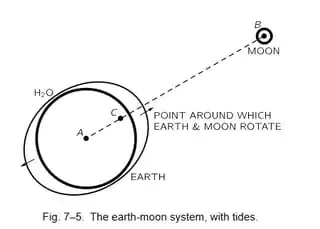I tried it this way. Consider two equal spherical with masses M, covered with a layer of water, circling around each other at a distance $l$ (measured between their centers). They have radius $R$ and angular velocity $\omega$.
Now let's look at one of them (the same applies to the other). For a point on the outside, (at distance $\frac 1 2 {l+R}$ from their CM) there are three forces:
$F_{cf}$, the centrifugal force directed away from the CM
$F_{gM}$, the gravitational force from the sphere we are looking at, directed towards the CM
$F'_{gM}$, the gravitational force from the other sphere, directed towards the CM
So for a test mass m:
$$F_{cf}=-\frac{mv^2}{{\frac 1 2}l+R}=-m{\omega}^2({\frac 1 2}l+R)$$
$$F_{gM}=m \frac{GM}{R^2}$$
$$F'_{gM}=m \frac{GM}{(l+R)^2}$$
Now we must find out if $F_{cf}$ pulls harder or less (or equal) on a test mass than (to) $F'_{gM}$.
We can write
$$M{\omega}^2({\frac 1 2}l)=\frac{M^2 G}{l^2}$$
so
$$MG={\frac 1 2}{\omega}^2 l^3$$
Putting this in the expression for $F'_{gM}$ gives:
$$F'_{gM}=\frac 1 2 m{\omega}^2\frac{l^3}{(l+R)^2}$$
So we have to find out if ${\frac 1 2}l+R$ is smaller or bigger (or equal) than (to) ${\frac 1 2}{\frac{l^3}{(l+R)^2}}$
Now we can write:
$${\frac 1 2}{\frac{l^3}{(l+R)^2}}={\frac 1 2}{\frac{l^3}{l^2+2lR+R^2}}={\frac 1 2}{\frac l {1+{\frac {2R}{l}}+{\frac{R^2}{l^2}}}}$$
which is obviously less than ${\frac 1 2}l +R$.
So we can conclude that for a mass $m$, on the outside of the spherical mass, the outward directed centrifugal force is bigger than the gravitational force caused by the other mass. Which implies an outward bulge develops.
We can apply the same procedure for the inside (the side that faces the other mass M) of the mass M, and that will show that the gravitational force from the other mass is bigger than the centrifugal force, which implies an inward bulge (towards the other mass) develops. I took two equal masses for simplicity, but you can do the same for two different spherical masses, circling around their CM. The result will remain the same (two bulges in opposite directions if both are covered with water; so if the moon was covered by a sea, also on the moon two bulges, on the line connecting the earth and the moon, would appear).
Looking at one mass I only had to compare the outward centrifugal force with the gravitational force caused by the other mass, so I didn't have to care about the force caused by the mass we were looking at, because they are equal everywhere (in approximation) on the surface of the mass, as is the case for the centrifugal force caused by an eventual rotation of the masses.
I didn't calculate if the bulges were different in size, but I guess they are.
